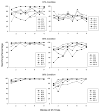Choice behavior of pigeons (Columba livia), college students, and preschool children (Homo sapiens) in the Monty Hall dilemma
- PMID: 22582816
- PMCID: PMC3435463
- DOI: 10.1037/a0028273
Choice behavior of pigeons (Columba livia), college students, and preschool children (Homo sapiens) in the Monty Hall dilemma
Abstract
In the Monty Hall dilemma, an individual chooses between three options, only one of which will deliver a prize. After the initial choice, one of the nonchosen options is revealed as a losing option, and the individual can choose to stay with the original choice or switch to the other remaining option. Previous studies have found that most adults stay with their initial choice, although the chances of winning are 2/3 for switching and 1/3 for staying. Pigeons, college students, and preschool children were given many trials on this task to examine how their choices might change with experience. The college students began to switch on a majority of trials much sooner than the pigeons, contrary to the findings by Herbranson and Schroeder (2010) that pigeons perform better than people on this task. In all three groups, some individuals approximated the optimal strategy of switching on every trial, but most did not. Many of the preschoolers immediately showed a pattern of always switching or always staying and continued this pattern throughout the experiment. In a condition where the probability of winning was 90% after a switch, all college students and all but one pigeon learned to switch on nearly every trial. The results suggest that one main impediment to learning the optimal strategy in the Monty Hall task, even after repeated trials, is the difficulty in discriminating the different reinforcement probabilities for switching versus staying.
Figures






References
-
- Behrend ER, Bitterman ME. Probability-matching in the goldfish. Psychonomic Science. 1966;6:327–328.
-
- Bitterman ME, Wodinsky J, Candland DK. Some comparative psychology. American Journal of Psychology. 1958;71:94–110. - PubMed
-
- Bullock DH, Bitterman ME. Probability matching in the pigeon. American Journal of Psychology. 1962;75:634–639. - PubMed
-
- Burns BD, Wieth M. The collider principle in causal reasoning: Why the Monty Hall Dilemma is so hard. Journal of Experimental Psychology: General. 2004;133:434–449. - PubMed

